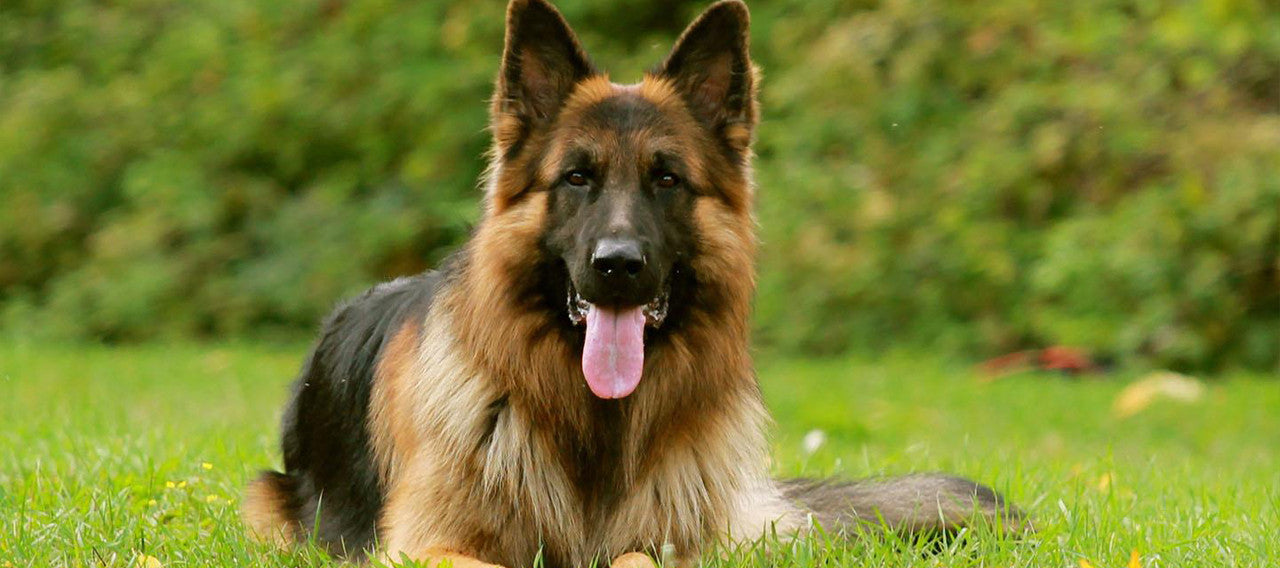Your Cart is Empty

The German Shepard’s breeding and training have led him to become a herding sheepdog, a leader of the blind, and a police dog. The police force, the armed services, prison officers, drug officers, and private protection agencies all over the world employ the German Shepherd, and is one of the most popular breeds in the world.
It may well be that the German Shepherd Dog, and his close Dutch and Belgian Shepherd relatives, have existed for thousands of years. Once known as the Alsatian, the German Shepherd Dog is the result of an effort to produce the ideal shepherd, capable of herding and guarding its flocks. At the end of the 19th century, Max von Stephanitz began a breeding program in Germany using long-haired, short-haired and wirehaired local shepherd dogs from Wurttemberg, Thurginia, and Bavaria. Von Stephanitz and other dedicated breeders produced the responsive, obedient, and handsome German Shepherd. The breed itself has proved to be a more than capable police dog, and subsequent breeding strove to perfect his abilities as an intelligent and fearless companion and guardian. By the beginning of World War I, the German Shepherd was popular throughout Germany, and spread throughout other parts of the world. During the War, 48,000 German Shepherds were enlisted with the German army which lead to many of them being taken forcefully from their owners. At the same time, the American Kennel Club (AKC) changed the breed’s name from German Sheepdog to simply Shepherd Dog, and Britain changed it to Alsatian Wolfdog. The breed name Wolfdog was later dropped as it caused many people to fear the dogs. In 1931, the AKC restored the breed’s name to German Shepherd Dog. The greatest increase to the breed’s popularity came in the form of two dogs, both movies stars: Strongheart and Rin Tin Tin. He remains one of the most versatile dogs ever created, providing service as a police dog, war dog, guide dog, search-and-rescue dog, narcotics or explosive detecting dog, show dog, guard dog, and family pet.
Slightly long in comparison to his height, he has an outline of smooth curves. Standing between 22 to 26 inches, his withers are high and sloping into his level back. He is strong, agile, and weighing between 75 and 95 lbs. His gait is exceptionally out-reaching, covering the ground in great strides. As a puppy, his black, tan or sable coat consists mostly of fine down, but as he matures his outer coat consists of dense, straight or slightly wavy, harsh, close lying hair of medium length. The upper part of his head narrows gradually from eyes to nose. His medium-sized, almond-shaped eyes show his intelligence; he does not miss a trick. His large black nose is extended to a flat tip. As a puppy, he will have folded ears but as he matures his ears stand high and erect. His fur is longer and more luxurious on his slightly curved tail. He has a deep chest and a moderate waistline. His thighs are strong and muscular, with leg bones carried slightly flexed. He also has arched, small, round, well-formed feet with large pads.
At his best, he is an intelligent, trainable dog with a pleasant, loyal disposition and makes a first-class household member. He is devoted and faithful. He is reliable, responsive, and obedient. Being attentive, alert, and resilient, he is steady of nerve, self-assured, courageous, and tractable and should never be over-aggressive or shy even though he is protective of his home and family.
When kept as a pet, the German Shepherd needs daily mental and physical challenges. He enjoys a good exercise and a learning session. If he does not get at least occasionally stimulated, he can be wilfully idle. On the other hand, most of them need to have their energies directed into useful pursuits as this breed in the working group originated as a shepherd dog. He can stay outside in temperate to cool climates, but he can be family oriented and does equally well as a housedog. His thick coat needs brushing 1 or 2 times weekly. Despite being a big dog, his feeding requirements are not demanding.
Having a life expectancy up to 12 to 13 years, there has been indiscriminate breeding which has unfortunately produced both physical and behavioural problems. Arthritis of the joints, eye disease, gastrointestinal disease, and other medical problems are seen to be the outcome of these thoughtless breeding programs. Behavioural problems such as nervousness, fearfulness, timidity, and aggression to other dogs do occur, but when bred carefully and responsibly, the German Shepherd dog is an excellent breed. Routine exercise is important for fluid muscle movement, wherein this breed has issues with a hereditary degeneration of the spinal cord which causes a progressively drunken gait. There are health issues that are unique to the breed which include,
The German Shepherd is also especially susceptible to a potentially fatal systemic fungal infection from Aspergillus which is an infectious disease that develops from different mold species found in various climates worldwide. As a responsible owner of this breed, it is suggested that in order to prevent these genetic health issues to develop, you should get your German Shepherd tested for his hips, elbows and eyes.
Known for his excellent skill, obedience and intelligence, the German Shepherd dog is perfect for you if you have the patience to train him, and time for daily walks and exercise. Apart from this, if you can provide him a home full of love and care, the German Shepherd dog will be your ultimate true companion and number one household pet.